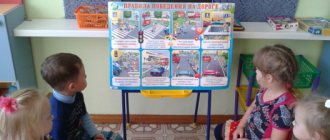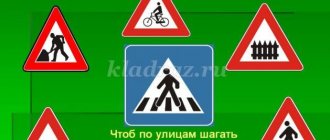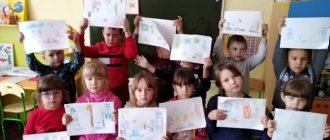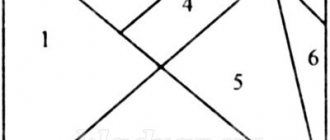MAGAZINE Preschooler.RF
Project “Learning traffic rules” in the senior groupPrepared by teacher Vechkanova Tatyana Vasilievna
Project participants: Group teacher; children of the older group, parents of pupils.
Project type: Content: educational - creative.
By number of participants: group (senior group children)
By duration: short-term (three weeks)
By nature: within the preschool educational institution
Relevance. The problem of preventing children's road traffic injuries is caused by the increase in road traffic accidents (RTA), in which not only adults, but also the younger generation - children - die and are injured. No one is left indifferent by disappointing reports about road accidents. A child is not a small adult, his body is in a state of growth and development, and not all mental functions necessary for adaptation to the outside world are fully formed. Children are very excitable, dynamic and at the same time absent-minded, they do not know how to foresee danger, correctly assess the distance to an approaching car, its speed and their capabilities. In many ways, the safety of a pedestrian depends on his compliance with the rules of behavior on the street, so it is necessary to teach children the rules of safe behavior on the roads through conversations - didactic games and exercises, outdoor games, role-playing games. It is known that habits established in childhood remain for life,
Therefore, today, more than ever, the prevention of road traffic injuries among preschoolers and their parents is relevant. A major role in solving this problem is the organization of work to prevent children's road traffic injuries in preschool institutions, since it is necessary to familiarize children with the rules of the road and develop the skills of correct behavior on the road from a very early age. And only together with parents, making maximum use of the authority of the family in the strong and conscious assimilation by children of not only the rules, but also the skills of safe behavior on the street, increasing their personal responsibility for the safety of their children, we hope to reduce child traffic injuries on the streets and roads our city
Goal: developing skills for safe behavior of children on the roads.
to form the idea of preschool children about traffic safety when moving along streets and roads.
Develop a sense of responsibility in children when following traffic rules
To develop skills in following the basic rules of behavior on the street and road in order to prevent children from road traffic injuries,
to cultivate a culture of behavior in children.
Tasks:
- Create conditions for children to consciously study the Rules of the Road;
- generalize and expand children's knowledge about traffic rules;
- introduce the concept of “distance” and “safe distance” ;
- increase your child’s level of knowledge on safe behavior on the streets and roads.
- promote the formation of an attitude towards safe behavior on the roads;
- develop motivation for safe behavior on the roads;
- develop in children the ability to determine a safe distance in various traffic situations.
- educate law-abiding road users;
- optimize work with parents of children of senior preschool age to study and consolidate knowledge about traffic rules using a variety of methods and techniques;
- encourage parents to be an example for their children in following traffic rules;
- to generate interest among parents in jointly teaching their children safe behavior on the roads;
- Establish warm, informal relationships between parents and parents and teachers.
- The project includes three stages:
- Preparatory stage.
- Main stage.
- The final stage.
Expected result:
Children: by the end of the project the child should:
- know the algorithm for crossing the road “stop - look - cross” ;
- be able to choose a way to cross the roadway, distinguish between pedestrian crossings (ground, overground, underground, regulated, unregulated) and traffic control devices (traffic lights, traffic controllers), as well as road signs;
- know the rules for crossing the roadway at regulated and unregulated pedestrian crossings,
- improve children's research activities;
- developed knowledge about road signs;
- compliance with basic traffic rules,
Parents:
- close cooperation with teachers;
- expanding the pedagogical literacy of parents on the issues of safe behavior of children on the roads.
Teacher:
- increasing safety knowledge;
- relationship with parents to create joint projects.
Stages of work on the project:
1. Preparatory stage.
Contents of activities of the teacher and children:
- choice of topic and its relevance;
- goal formulation and definition of objectives;
- selection of material on the Project topic:
- selection of methodological, popular science and fiction literature, illustrative material on this topic
— selection of toys, attributes for play and theatrical activities according to traffic rules.
- selection of information for the parent corner
- musical selection of songs
- selection of didactic, story games, physical exercises
- drawing up a plan for the main stage of the Project;
- survey of children.
Working with parents:
- Conversation with parents about upcoming work on the project.
- Announcement of the start of the project and its tasks.
2. Main stage
Contents of activities of the teacher and children:
- Conducting a series of classes on traffic rules:
- "Children's behavior in public transport",
- "Introduction to the work of a driver",
- "I'm walking down the street",
- "Road signs",
- "Safe behavior on the street"
- Introduction to fiction: E. Zhitkov “Traffic Light” , S. Mikhalkov “My Street” , “Uncle Styopa” N. Kalinin “How the Guys Crossed the Street” , V. Sirotov “Your Comrade Traffic Light” , P. V. Ivnev “How the street is talking” , I. Seryakov “The Laws of Streets and Roads” , A. Ivanov “How Inseparable Friends Crossed the Road” , L. Galpershtein “Barrier” , G. Yurmin “Curious Mouse” .
- Reviewing road safety posters with children.
- Riddles about transport.
- Counting tables.
- Proverbs
- Conversations:
- "Road Safety"
- “Always remember road signs”;
- "Careful, road!";
- "Transport on the city streets";
- "Rules for passengers";
- "Rules of conduct for pedestrians",
- "School of Pedestrian Sciences",
- "Traffic Violations",
- "History of Transport",
- "Driver's work",
- "How to behave on the bus",
- "Special purpose vehicles",
- "Adjuster".
- Writing creative stories: “What would happen if all the road signs disappeared?” ; “What would happen if there were no traffic rules?” ; "Stories in Transport" ; "An interesting incident on the road" .
- Observations:
- For modes of transport,
- for the driver's work.
- Didactic games: “Road signs” , “Traffic light” , “Guess” , “Our street” , “Logical path” , “Put up a road sign” , “Be careful” , “Lay out correctly” , “Find out by description” . “Arrange the signs” (games with an intersection layout), “Dial the number correctly” , “Find the same sign” , “Collect the sign” .
- Outdoor games: “Gestures of a traffic controller” , “Stop” , “Traffic light” . “Traffic Controller” , “Red, Yellow, Green” , “Skillful Pedestrian” , “Best Pedestrian , “Traffic Signals” , “Pedestrians and Cars” , “Road Signs and Cars” , and others.
- Role-playing games: “Caution, street!” , “Ride the Bus” , “Traffic Rules” , “Car” .
- Artistic and creative activities:
- drawing “Road signs” ,
- application “Road signs” , “Modes of transport” (collective works),
- designing “My Street” ,
- modeling: “Cheerful traffic light” , “Car” .
Working with parents:
- joint activities of parents and children in the selection of children's poems and works on traffic rules;
- consultations for parents on traffic rules:
- “How to teach a child to follow traffic rules”,
- Consultation for parents on the topic “Children’s safety is the concern of adults .
- "About behavior in public transport"
- “On the importance of teaching preschool children traffic rules”.
- reminders for parents
- “Teaching preschoolers traffic rules”;
- “How to teach a child the rules of behavior on the street”.
- "A child crosses the street".
- moving folders:
- “Adults! Children imitate you!” .
- “Discipline on the street is the key to pedestrian safety”
- card index of didactic games on traffic rules;
- a card index of outdoor games for children to learn traffic rules;
- parent testing:
- “Questionnaire for parents on traffic rules”,
- “Studying parents’ attitudes towards the need to teach children traffic rules.
Responsible for implementation: teacher, children, parents.
3. Final stage
Contents of activities of the teacher and children:
Exhibition of joint work by parents and children on traffic rules.
Design of the traffic rules corner.
Analysis of the results obtained.
Conclusion: Based on the results of the Project, we can say that the formation of safe behavior of preschool children on the roads and streets is a long and labor-intensive process, but very exciting and educational not only for children, but also for adults. I would like to hope that work in this direction will bring good results in the future, and the knowledge acquired by the children will help them avoid troubles on the road.
Conclusion:
The use of this project contributes to a deeper understanding by children of traffic rules, consolidation of knowledge and skills, the formation of a conscious attitude towards their observance, the development of a sense of control, self-control, responsibility and the prerequisites for readiness to be responsible for their actions.
Every year, hundreds of traffic accidents occur on the roads of cities in our country, as a result of which dozens of children die, hundreds are injured and injured. That is why road traffic injuries remain a priority problem of society that requires solutions with everyone’s participation and the most effective methods. The first teacher who can help society solve this problem should be a kindergarten teacher. It is known that many parents have little knowledge of traffic rules and have a vague understanding of this problem. In this regard, teaching parents the rules of the road is of great importance. As mentioned above, the traffic rules are the same for children and adults. Unfortunately, they are written “adult” language without any consideration for children. Therefore, the main task of educators and parents is to clearly explain the rules to the child, and when choosing a form of education, to convey to the children the meaning and danger of non-compliance with the rules, without distorting their content. Only through the joint efforts of educators and parents, using their knowledge, patience and tact, is it possible to teach our children the skills of safe communication with the complex world of crossing streets and roads. The proposed project is an attempt to organize in practice a system of activities for parents and teachers of preschool educational institutions to teach preschoolers the basic rules of movement and instill in them the habits and behavior of skillful and careful pedestrians. We are convinced that such a system of working to teach children traffic rules undoubtedly produces positive results; the most important thing in our project is that we were able to interest parents and children in this problem. During the implementation of this project, preschoolers became familiar with the rules of the road and safe behavior on the roads in an accessible, entertaining, playful way.
Work with parents: Invite parents to continue working on developing their children’s knowledge of traffic rules
Literature:
- Avdeeva N.N., Knyazeva N.L., Sterkina R.B. Safety. A textbook on the basics of life safety for children of senior preschool age. – SPb.: “CHILDHOOD-PRESS” , 2003.
- Polynova V.K. Fundamentals of life safety for preschool children. Work planning. Conversations. Games - St. Petersburg: PUBLISHING HOUSE "CHILDHOOD-PRESS" , 2010
- Complex classes for children 4 – 7 years old / author. - comp. O.F. Gorbatenko. Ed. 2nd, add. – Volgograd: Teacher, 2013
- Open events for older children. Educational field “Artistic and aesthetic development” . A practical guide for senior educators, methodologists and teachers of preschool educational institutions, parents, tutors. – Auth. – comp.: Adzhi A.V., Kudinova N.P. Voronezh: LLC "Metoda" , 2014.
- I.Yu. Bordachev’s visual didactic manual “Road Signs” for children 4 – 7 years old Publishing house “MOSAIKA-SINTEZ”, 2013
- Krutetskaya V.A. My first road alphabet in pictures. – St. Petersburg: Publishing House “Literature” , 2012.
- www. detibdd. ru
- https://bezdtp. ru/bezdtp/ru/about
- Saulina T.F. Three traffic light signals: Familiarization of preschoolers with the rules of the road: For working with children 3-7 years old. – M.: MOSAIC – SYNTHESIS, 2010.
| Next > |







